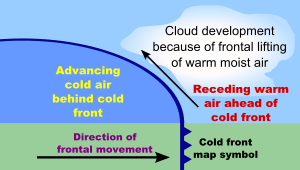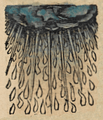Rain facts for kids
Rain is a type of precipitation. Precipitation is any form of water that falls from clouds in the sky. This includes rain, hail, sleet, and snow. We measure how much rain falls using a special tool called a rain gauge. Rain is a very important part of the water cycle on Earth.
Some places get a lot of rain, which helps create thick rainforests. Other places get very little rain, leading to deserts.
A rainstorm is when a lot of rain falls suddenly and heavily. Strong rainstorms can sometimes cause flash floods in low areas or even bigger floods that can damage homes. Heavy rain can also lead to landslides, where soil and rocks slide down hills.
Contents
How Does Rain Form?
Rain forms in different ways depending on how air moves and cools. Here are the main types of rain:
Convectional Rain
When the Sun heats the ground, the air above it also gets warm. This warm air then rises, just like a hot air balloon. As the air rises higher, it cools down. When it cools enough, the water vapor in the air turns into tiny water droplets, forming clouds. If these clouds get full of water, rain will fall. This type of rain often happens on flat land and can cause summer showers or thunderstorms.
Relief Rain
Relief rain often happens near coasts where there are hills or mountains. Imagine wet air blowing from the sea towards the land. When this moist air hits a mountain, it has to rise up and over it. As the air climbs higher, it cools down. The water vapor in the cool air then condenses into clouds. When the clouds can't hold any more water, rain falls on the side of the mountain facing the wind (called the windward slope).
After the air goes over the mountain, it sinks down the other side (called the leeward slope). As it sinks, it gets warmer and drier. This means the leeward side of the mountain usually gets very little rain and is known as a rain shadow. The places in the world that get the most rain often have relief rainfall.
Frontal Rain

Frontal rain happens when a mass of cooler air meets a mass of warmer, moist air. The warmer air is lighter, so it rises up over the cooler air. As the warm air rises, it cools down, and the water vapor in it forms clouds. These clouds grow larger and eventually produce rain. This type of rain is common in many parts of the world.
Collecting Rainwater
Some people collect rain in a rainwater tank. This collected rainwater can be used for many things, like watering plants, cleaning, or even bathing. However, it's usually not safe to drink rainwater directly without treating it first. It can contain bacteria, parasites, viruses, or chemicals that could make people sick.
Related Topics
Images for kids
-
Rain falling on a field in southern Estonia
-
Image of Atlanta, US showing temperature distribution. Blue is cool, red is warm, and white is hot.
-
A band of thunderstorms seen on a weather radar display
-
A rain dance being performed in Harar, Ethiopia
See also
 In Spanish: Lluvia para niños
In Spanish: Lluvia para niños




















